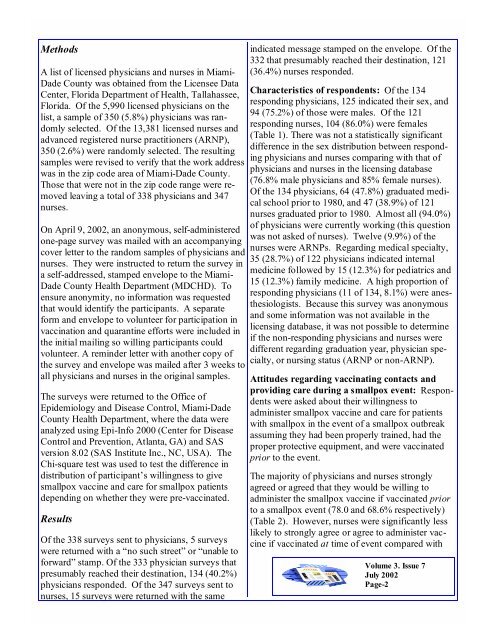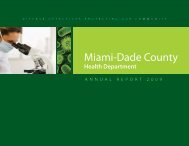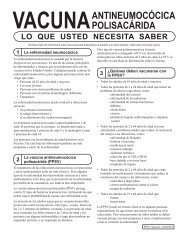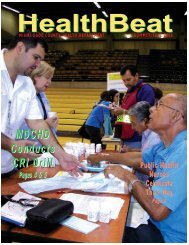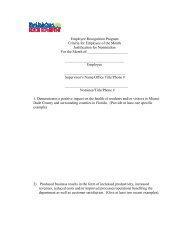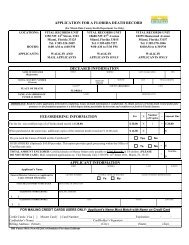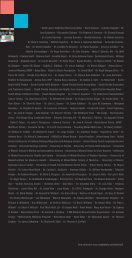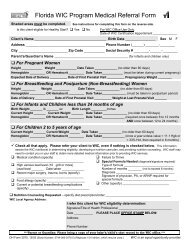Knowledge and Attitudes About Bioterrorism and Smallpox: A ...
Knowledge and Attitudes About Bioterrorism and Smallpox: A ...
Knowledge and Attitudes About Bioterrorism and Smallpox: A ...
Create successful ePaper yourself
Turn your PDF publications into a flip-book with our unique Google optimized e-Paper software.
Methods<br />
A list of licensed physicians <strong>and</strong> nurses in Miami-<br />
Dade County was obtained from the Licensee Data<br />
Center, Florida Department of Health, Tallahassee,<br />
Florida. Of the 5,990 licensed physicians on the<br />
list, a sample of 350 (5.8%) physicians was r<strong>and</strong>omly<br />
selected. Of the 13,381 licensed nurses <strong>and</strong><br />
advanced registered nurse practitioners (ARNP),<br />
350 (2.6%) were r<strong>and</strong>omly selected. The resulting<br />
samples were revised to verify that the work address<br />
was in the zip code area of Miami-Dade County.<br />
Those that were not in the zip code range were removed<br />
leaving a total of 338 physicians <strong>and</strong> 347<br />
nurses.<br />
On April 9, 2002, an anonymous, self-administered<br />
one-page survey was mailed with an accompanying<br />
cover letter to the r<strong>and</strong>om samples of physicians <strong>and</strong><br />
nurses. They were instructed to return the survey in<br />
a self-addressed, stamped envelope to the Miami-<br />
Dade County Health Department (MDCHD). To<br />
ensure anonymity, no information was requested<br />
that would identify the participants. A separate<br />
form <strong>and</strong> envelope to volunteer for participation in<br />
vaccination <strong>and</strong> quarantine efforts were included in<br />
the initial mailing so willing participants could<br />
volunteer. A reminder letter with another copy of<br />
the survey <strong>and</strong> envelope was mailed after 3 weeks to<br />
all physicians <strong>and</strong> nurses in the original samples.<br />
The surveys were returned to the Office of<br />
Epidemiology <strong>and</strong> Disease Control, Miami-Dade<br />
County Health Department, where the data were<br />
analyzed using Epi-Info 2000 (Center for Disease<br />
Control <strong>and</strong> Prevention, Atlanta, GA) <strong>and</strong> SAS<br />
version 8.02 (SAS Institute Inc., NC, USA). The<br />
Chi-square test was used to test the difference in<br />
distribution of participant’s willingness to give<br />
smallpox vaccine <strong>and</strong> care for smallpox patients<br />
depending on whether they were pre-vaccinated.<br />
Results<br />
Of the 338 surveys sent to physicians, 5 surveys<br />
were returned with a “no such street” or “unable to<br />
forward” stamp. Of the 333 physician surveys that<br />
presumably reached their destination, 134 (40.2%)<br />
physicians responded. Of the 347 surveys sent to<br />
nurses, 15 surveys were returned with the same<br />
indicated message stamped on the envelope. Of the<br />
332 that presumably reached their destination, 121<br />
(36.4%) nurses responded.<br />
Characteristics of respondents: Of the 134<br />
responding physicians, 125 indicated their sex, <strong>and</strong><br />
94 (75.2%) of those were males. Of the 121<br />
responding nurses, 104 (86.0%) were females<br />
(Table 1). There was not a statistically significant<br />
difference in the sex distribution between responding<br />
physicians <strong>and</strong> nurses comparing with that of<br />
physicians <strong>and</strong> nurses in the licensing database<br />
(76.8% male physicians <strong>and</strong> 85% female nurses).<br />
Of the 134 physicians, 64 (47.8%) graduated medical<br />
school prior to 1980, <strong>and</strong> 47 (38.9%) of 121<br />
nurses graduated prior to 1980. Almost all (94.0%)<br />
of physicians were currently working (this question<br />
was not asked of nurses). Twelve (9.9%) of the<br />
nurses were ARNPs. Regarding medical specialty,<br />
35 (28.7%) of 122 physicians indicated internal<br />
medicine followed by 15 (12.3%) for pediatrics <strong>and</strong><br />
15 (12.3%) family medicine. A high proportion of<br />
responding physicians (11 of 134, 8.1%) were anesthesiologists.<br />
Because this survey was anonymous<br />
<strong>and</strong> some information was not available in the<br />
licensing database, it was not possible to determine<br />
if the non-responding physicians <strong>and</strong> nurses were<br />
different regarding graduation year, physician specialty,<br />
or nursing status (ARNP or non-ARNP).<br />
<strong>Attitudes</strong> regarding vaccinating contacts <strong>and</strong><br />
providing care during a smallpox event: Respondents<br />
were asked about their willingness to<br />
administer smallpox vaccine <strong>and</strong> care for patients<br />
with smallpox in the event of a smallpox outbreak<br />
assuming they had been properly trained, had the<br />
proper protective equipment, <strong>and</strong> were vaccinated<br />
prior to the event.<br />
The majority of physicians <strong>and</strong> nurses strongly<br />
agreed or agreed that they would be willing to<br />
administer the smallpox vaccine if vaccinated prior<br />
to a smallpox event (78.0 <strong>and</strong> 68.6% respectively)<br />
(Table 2). However, nurses were significantly less<br />
likely to strongly agree or agree to administer vaccine<br />
if vaccinated at time of event compared with<br />
Volume 3. Issue 7<br />
July 2002<br />
Page-2


